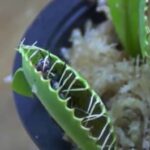As an Amazon Associate, this site earns commissions from qualifying purchases. For more details, click here.
Sundew plants are not that difficult to grow as long as you follow the right steps. If this is your first time to cultivate this plant, or you own one and it is in poor health, this guide is for you. Here we reveal the reasons why sundews can suddenly die and what preventive steps you can take.
Sundews prefer humid, watery conditions, and abrupt changes to this environment can kill the plant. Other causes of sundew death are use of fertilized soil, lack of light and not enough water.
Not Enough Light
Carnivorous plants share some things in common with houseplants, and that includes the need for light. Sundews cannot live without light as they require it for energy production..
Sundews must have 6 to 12 hours of light every day. Natural and indoor grow lights both work, and if you can provide up to 14-16 hours that is even better.
The best set up for sundews is 12 hours of natural light. A few hours of direct sunlight around noon and indirect sunlight in the morning and the rest of the afternoon. If it is too hot, limit its direct sunlight exposure.
Ideal situations are not always possible. If there are less than six hours of light available, grow indoors with the Aceple LED Grow Light. Set the light at least six inches away from the sundew and leave it on for 6 to 8 hours. Some sundews prefer up to 14 hours so observe how the plant responds.
Without light sundews will die, period. They can live for a long time without eating bugs (though not recommended). But without enough light the plant will not be able to produce energy required for its daily activities.
Some sundews require more light than others. Their needs depend on the habitat, so check your hardiness zone to get an idea of what its temperature range is.
While sundews require light, too much heat can cause sunburn. The optimal temperature range for sundews is 45 to 75 F, but most species will be fine up to 100 F. Anything above that and you have to provide shade for the plant.
It is important to distinguish between light and heat. While sundews benefit from light, too much heat – above 100F- will harm the plant. Heat could cause sundews to turn red and lose their dew. And without dew there is no way it can catch insects.
Low Humidity
The optimum humidity level for sundews is 40-60%. The easiest way to achieve this is to place the sundew on a tray filled with a few inches of water.
Learning how to sit sundews in water is easy. Once you have a tray, just fill it with water when required. This should be enough to keep the humidity high enough for the plant.
Leaving sundews in low humidity puts it at risk of drying out or dying. Combine this with lack of water and the plant will lack the energy needed to survive.
Some sundews cope well with lower humidity The drosera capensis, drosera pulchella and drosera burmannii can even grow at 20% humidity at 95 F. However this is an extreme case and you should keep the humidity at 40-60% and the temperature between 45-85 F.
Tuberous sundews however, prefer a 60% humidity rate. Droera cistiflora also flourish at 50% humidity rate and anything lower than 40%, the plant could die.
Some tuberous sundews like the drosera stolonifera will enter dormancy if the temperature climbs over 75 F. Tuberous sundews have different requirements from regular sundews, so do some research if you want to buy one of these.
You can also install a humidifier such as the Elechomes SH8830 to control humidity. This is a good option if you live in a low humidity environment or the plant needs additional moisture.
You might also want to seal the tray when growing sundew seeds. This prevents moisture from escaping and keeps the atmosphere cool. Once you place the seeds in the tray, add an inch or two of water. Then wrap plastic around the tray so nothing is exposed. The point is you have to keep the humidity at the proper level for your seeds to live.
Use of Rich Soil
Do not use regular potting soil on sundews. Typical pot soil is rich in nitrogen and this is fatal to the plant. Use only long fibered sphagnum or peat moss.
Mix peat moss or long sphagnum with perlite or silica sand equal parts. Follow the instructions that come with your soil mixture.
Sundews can live for several years but only if planted in the right soil. So before you buy one, make sure you have the right mixture ready.
Sundews only grow in poor soil, that is soil with little to no nutrients. Because these plants need nitrogen to grow, they developed traps to capture insects. Flies, spiders, mosquitoes and other bugs contain the nitrogen that is lacking in the soil.
Sundews receive all the nutrients they require from insects. If your plant is indoors, you can give it beta fish pellets, mealworms or insects as nutrients. But you cannot grow it in fertilized soil.
Sundews have to get nitrogen from insects and other prey, not the ground. Their system cannot accept nitrogen from the soil. Doing this will weaken the plant and kill it quickly.
It is not clear why sundews can absorb nitrogen from living creatures but not the soil. It probably has to do with the way the plant has evolved. Because sundews only grow in poor soil, they have become accustomed to absorbing nutrients via their mucilage (the dew).
Once a prey is trapped in the mucilage, its tentacles wrap itself around the creature and pull it into spoon shaped leaves. There the plant releases enzymes to dissolve the insect. Once the tissues are melted, the plant absorbs it.
If nutrients were present in the soil, the plant might not know how to absorb it. This would also render the mucilage useless.
Lack of Water
Sundews that do not get enough water will weaken and die. How much water they need depends on the temperature and humidity. But the most important thing is the soil must always be moist.
Sundews should sit in water so it remains cool. A couple of inches of water for a 10 inch deep container is fine. You can always add more if the leaves look dry. You can tell if a sundew needs more water by its color. Dull looking leaves almost always means the plant needs more water.
Use either rainwater, reverse osmosis or distilled water. These are proven safe for plants and do not have any impurities that could hurt it.
If you do not want to use the tray method, you can water sundews from the top. Do not pour water on the leaves as this could wash out the mucilage. If it gets really hot, water frequently. You can install a humidifier to cool the air. Misting sundews is not a good idea for many reasons.
Feel free to adjust the amount of water if you use the tray method. Some sundews can handle more water especially during summer. Every four weeks, remove the sundew from the tray and let the container dry.
Drying prevents fungus and bacteria from building up. These can spread quickly and kill your sundews along with any plants near it.
Sundews can grow in terrariums. It might help produce high humidity if the set up is correct. However, terrariums might also lead to heat buildup, so check first if your sundew variant is suited for this or not.
Conclusion
Like all plants, sundews can live for many years if grown in the right way. So it is important that you understand the effect environment has on the plant. This makes a huge difference on how long your sundew will live.

My fascination with carnivorous plants began many, many years ago with Venus Fly Traps. Now I am more than happy to impart what I know with other enthusiasts and those who are curious about meat eating plants.



